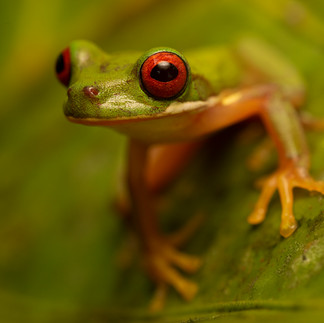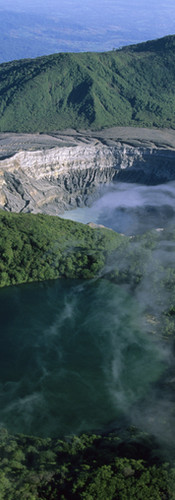"Exploring Herpetological Diversity: Discovering Amphibian and Reptile Species in Costa Rica".
Costa Rica is one of the most biodiverse countries on the planet, that is something we all know. However, not in total numbers, because if so, it wouldn't even reach the top 10. Its current figures show a diversity of 220 amphibian species and 254 reptile species (474 in total). This is far from the 1678 in Brazil, 1173 in Colombia, and numbers from Ecuador, Indonesia, Mexico, Peru, Venezuela, and even Panama. But if we take into account its reduced surface area of only 51,100 km2, then it stands out as the most biodiverse country per its area. It's not the same to possess 1600 species in 8 million km2, than 474 in 50,000.
It is also known for its overwhelming biomass, that is, the number of individuals of the same species. This is especially noticeable in small animals such as invertebrates, amphibians, and reptiles.
In summary, it can be said that in Costa Rica, you can see more species and in greater abundance than in similar countries.

What is "herping"?
"Herping" is the term used for seeking out and observing reptiles and amphibians in their natural habitat. It often refers to venturing out into the field or nature to look for these animals, and can also include capturing and studying them. If we had to coin a verb in Spanish for this activity, it would be "herpetear".

How to do "herping"?
How is "herping" practiced?
There are several steps to do "herping":
Research the area where you plan to go herping. Find out what species of reptiles and amphibians live there and what time of year they are most active.
Prepare adequately: Make sure to have appropriate clothing and footwear for walking in the field depending on the weather and time. You will also need cameras and a herpetological hook or a net for aquatic species (if you plan to capture animals for study). Use a flashlight to search for reptiles and amphibians in the dark.
Go into nature: Go out into the field during the active hours of reptiles and amphibians. Look in places like puddles, bushes, and rocks where these animals may be hiding. Depending on the geographic location, there are terrestrial (including fossorial), arboreal, semi-aquatic, and aquatic or marine species.
Use tracking techniques: Some animals (iguanas, crocodiles, turtles) leave certain marks where they pass. These can be recognized to find hidden reptiles and amphibians. Look for footprints, droppings, and other traces left by the animals.
Be patient: Herping can be a search activity, and it's important to have patience. Reptiles and amphibians can be difficult to find, and it may take several attempts before you are successful.
Observe and study: Carefully observe the animals you find. Take photos or videos if you can, and note down any relevant information like the species, size, location, and behavior. If it is not necessary (for example when studying or rescuing them), do not capture animals; each capture is unnecessary stress for the animal.
Respect the animals: Remember that these animals are living beings and should be treated with respect. Do not disturb or harm them, and return the animals to their natural habitat after studying them. Amphibians should never be touched with bare hands. If it is necessary to do so, always use gloves (preferably biodegradable nitrile ones). It's important to mention that some species of reptiles and amphibians are protected by laws and regulations, it's necessary to familiarize yourself with local rules and obtain necessary permits before initiating any herping activity.

Introduction to Costa Rica and its herpetofauna.
Costa Rica, despite being so small, has four basic bioregions, which are; the Caribbean versant or slope; the dry Northern Pacific, the humid Southern Pacific and the high Mountains and volcanoes.
The Caribbean slope. The largest surface area in the country corresponds to the eastern side to the east of the Cordillera de Talamanca and the central Volcanic Cordillera. It consists of cloud forests and rainforest between the border of Panama in the southeast to Nicaragua to the northeast. It is undoubtedly the most biodiverse area in the country, with approximately 65% of reptile and amphibian species.
From the north (Barra del Colorado, Tortuguero), Sarapiquí and surroundings, towards the central Caribbean slope, such as Siquirres, Guapiles, Matina, Liverpool, etc… to the South Caribbean (Bananito, Pandora, Hitoy Cerere, Puerto Viejo, Manzanillo), up to 290 species of amphibians and reptiles find their habitat. Some are so spectacular that the best opportunity to see them will always be with specialized guides who know their biology and can lead you on this wonderful experience.
Some of the most recognized and desired species are the tiger frog Cruziohyla sylviae, the flying frog Agalychnis spurrelli, the lemur frog Agalychnis lemur, among the rarest and most spectacular. Other more common ones, also impressive, include the red-eyed frog Agalychnis callidryas, with its largest populations and beautiful colors; glass frogs as beautiful as Sachatamia ilex and Hyalinobatrachium valerioi, H. chirripoi and H. talamancae, and poison frogs such as three morphs of Oophaga pumilio (Blue jeans, black jeans and bribri), Phyllobates lugubris and Dendrobates auratus.
Among reptiles, it will also be easy to spot some classic Costa Rican species such as the emerald basilisk Basiliscus plumifrons, the green iguana Iguana rhinolopha, the spectacled caiman Caiman c. fuscus and the American crocodile Crocodylus acutus. Many other small lizards fill the rainforest, such as anoles, geckos, and microteids.
Without a doubt, one of Costa Rica's best-known jewels is the oropel, the yellow phase of the bocaracá or eyelash viper (Bothriechis schlegelii). Although throughout its distribution there are a lot of different variants, it is precisely in the Caribbean where the greatest variety is observed, some as wonderful as the yellow oropel itself, but also phases as attractive as pink, white or green with orange. Other vipers that we can easily seen are the fer-de-lance Bothrops asper, in fact the most abundant and dangerous in Central America; and the long-nosed viper or tamagá (Porthidium nasutum). Although usually the biggest prize, the ultimate viper, is Lachesis stenophrys.

The coastline of the Pacific Ocean is long and contains two major biotopes, the Northwest (tropical dry forest) which basically begins to the north of the Tárcoles River and mainly encompasses the provinces of Alajuela and Guanacaste, and on the other hand, the humid south, starting south of this river, where becomes rain forest west of the Cordillera de Talamanca, particularly in the province of Puntarenas.
The Pacific North. The coasts of the northwest area are well known as a vacation destination, as they are considered some of the best in the country. The interior of the Nicoya peninsula is rural and has dry forest on a karstic substrate with caves. There are plains and hills with xerophytic vegetation, protected by National Parks such as Palo Verde, Santa Rosa and Guanacaste. The dry season is somewhat longer than the rainy season, which is restricted from June to November. There are also some mountain ranges and a series of volcanoes (Tilarán, which includes the cloud forests of Monteverde; Rincón de la Vieja, Cacao and Tenorio volcanoes, all interesting and worth exploring).

South Pacific. To the south of the Tárcoles River and up to the border with Panama, always to the west of the Talamanca Mountain Range, there are lowland rain forests (Osa, Costa Ballena, Golfito, Quepos, Parrita) that gradually ascend to little-explored cloud forests. This area had been little visited until about 15 years ago, when the coastal highway has facilitated the penetration and tourist development of many towns, especially coastal ones (Jacó, Quepos, Dominical, Uvita, Sierpe, Drake, Puerto Jimenez), and at the same time it has made it more accessible to any naturalist wishing to explore its magnificent jungles and little-known diversity.
In the North Pacific (tropical dry forest zone), especially visiting it at the beginning of the rainy season, you can see many species that remain hidden the rest of the year; they take advantage of the first rains to aggregate and reproduce, showing their behavior and their best colors. An example is that of the drunken toad (Rhinophrynus dorsalis), one of the most peculiar anurans in the world, and endemic to Central America; also the golden toadsIncilius luetkenii, the sheep frogs (Hypopachus variolosus), the boisterous tree frogsSmilisca baudinii, and thousands of little frogs likeDendropsophus microcephalus andScinax staufferi.
Many snakes are also activated by such abundant food, such as the burrowing python Loxocemus bicolor, the arboreal snakes Imantodes gemnistratus, Oxybelis fulgidus and Sibon anthracops, big racers as Trimorphodon quadruplex, Senticolis triaspis, Scolecophis atrocinctus, Drymarchon corais, Masticophis mentovarius.... With more luck you can see a tropical rattlesnake (Crotalus simus), and with great luck, the snail-eater Geophis (Tropidodipsas) sartorii, only known from very few records in Costa Rica; and the magnificent and beautiful cantil or tropical moccasin Akgistrodon howardgloydi.
The South Pacific changes its landscape radically and is more like the rain forest of the Caribbean, with giant trees and a forest overflowing with lush green. Many species unique to this area are present, such as snakes Siphlophis compressus, Corallus ruschenbergerii, Epicrates maurus, Leptodeira rubricata, Chironius flavopictus, Porthidium porrasi and the queen, the black-headed bushmaster Lachesis melanocephala. On the Pacific coast occurs the only marine snake in the Americas, Hydrophis platurus, but in the Golfo Dulce, a population of small size and totally yellow (H. p. xanthos) is found in this tropical fjord. Three species of corals, Micrurus yatesi, M. nigrocinctus and the rarest and most beautiful, M. clarki They are also in the area. Of course, one of the most beautiful and common snakes is the famous bocaracá or eyelash snake, Bothriechis schlegelii. The famous and dangerous fer de lance is also common (Bothrops asper).
Among amphibians, the South Pacific is home to several specialties. After or during heavy rains, active caecilians can be found, such as Dermophis, Gymopis or even the endemic Oscaecilia osae in the Golfo Dulce area and Peninsula de Osa. Three species of salamanders are relatively common, Bolitoglossa lignicolor, Oedipina pacificensis and Oedipina alleni. Some frogs are also unique to this area, such as Incilius aucoinae, Smilisca sila, the gladiator frog Boana rosenbergii, Craugastor stejnegerianus, C. rugosus, the granular poison frogs with different variants Oophaga granulifera and the stripped poison dart frog Phyllobates vittatus. And as mentioned, Agallychnis callidryas of the Pacific look very different from those of the Caribbean. This is where the gliding frog Agalychnis spurrelli stars in aggregations of thousands of individuals reproducing at the same time. Several species of glass frogs also abound in the area, such as Hyalinobatrachium valerioi, H. colymbiphyllum, Sachatamia albomaculata, Teratohyla pulverata, Cochranella granulosa, Espadarana prosoblepon and the very rare Hyalinobatachium vireovittatum.


Central area and mountains.
Undoubtedly, the central zone of the country, around the capital, San José, has developed in an extreme and chaotic way, alienating the naturalist tourist from that region. However, without going too far we can find montane cloud forest environments still well preserved with some iconic species, such as the green palm viper (Bothriechis lateralis) and even the black-speckled pal pitviper (Bothriechis nigroviridis). There are volcanoes like Poas, Irazú and Turrialba, which are well worth a good visit, both during the day and at night.

In the higher areas, especially towards Cerro de la Muerte, a popular destination to observe quetzals, it is also possible to find species such as lizards Sceloporus malachiticus, Mesaspis (Abronia) monticola, salamanders like Bolitoglossa pesrubra, B. tica and B. cerroensis and snakes like Lampropeltis gaigeae, Clelia scytalina, Cerrophidion sasai and Bothriechis nubestris.
Further south, near the border with Panama, is the city of San Vito, where in its surroundings there is a particular fauna, standing out the mountain eyelash viper Bothriechis supraciliaris, Norops aquaticus, Centrosaura apodema, the harlequin toad Atelopus varius and already ascending to 2000 m and more, the habitat of incredible species that unfortunately disappeared as Atelopus chiriquiensis, Isthmohyla calypsa, Incilius fastidiosus, etc... that we do not lose hope of meeting again one day.

Why hire experienced guides or specialized companies ?
Just as bird watching has become a very important niche within the country's tourism, "Herping" is an activity that is clearly booming throughout the world. In recent years, specialists and amateur guides have developed a series of tours or expeditions dedicated exclusively to herps (amphibians and reptiles), animals that were barely observed in specialized tours of birds or nature in general.
Costa Rica is a very popular tourist destination that can present some challenges for visitors. Some of the main problems that tourists in Costa Rica face include:
Language: The official language of Costa Rica is Spanish, so it can be difficult to communicate with people if you don't speak this language. However, in tourist spots and in major cities, you are likely to find someone who speaks English.
Transport: Public transportation in Costa Rica can be difficult for some tourists to understand and use. It is advisable to plan ahead and consider renting a vehicle or hiring a private transportation service to facilitate mobility. Many interesting areas are remote and special vehicles (not just any rental 4x4) are needed to access.
Safety Considerations: Costa Rica is widely regarded as a safe destination, yet, as with any location, it is not immune to instances of theft and minor criminal activities. It is prudent to maintain basic safety measures. These include refraining from carrying excessive cash and being discerning about when, where, and how to store your high-value possessions.
Climate: The weather can vary significantly in different parts of Costa Rica. It is important to be prepared for rain, heat and humidity, or cold depending on the area, and wear appropriate clothing and footwear.
Environmental Protection: Costa Rica is known for its biodiversity, and it is important to respect and preserve its nature and ecosystems. It is important to follow environmental rules and regulations and not harm natural ecosystems.
Prices: Costa Rica is a popular tourist spot and prices can be higher than in other parts of Central America. It is important to plan ahead and take into account the costs of accommodation, transportation, food and activities.
All these inconveniences can be easily and quickly resolved by specialized companies, which can allow you to maximize investment and time in only the activities that interest you and not waste valuable time solving problems.
CRWild (www.crwild.com) emerges as the first company dedicated to the observation of amphibians and reptiles in Costa Rica, also operating in other countries such as Guatemala, Panama, Mexico and Colombia for the moment
(https://www.crwild.com/herping-expeditions). Every year expeditions are offered from 8 to 14 days touring "hotspots" in each of these countries, in search of their most characteristic and spectacular herpetofauna.
From true expeditions that involve camping in remote areas in search of the most elusive animals, to guided outings in luxury lodges where, after photographing the desired species, they can rest and chat by the pool over a mojito, CRWild offers in its wide range a whole range of possibilities, night walks in any part of the country with the most renowned local guides (https://www.crwild.com/night-herping-tours) and customized expeditions in search of each client in search of the most interesting species (https://www.crwild.com/tailor-made-herping-tours).
CRWild is not only tours and expeditions. It also includes a very important collection of herpetological research begun in the 1990s and endorsed each passing year with multiple publications (https://www.crwild.com/publications).
In addition, CRWild offers free rural snake talks to communities to learn about these misunderstood and disrespected creatures. It also offers training to hotels, guide associations or other groups on reptiles, particularly snakes, and snake handling courses in collaboration with national serpentarists (https://es.crwild.com/trainings).
Part of the profits from expeditions and tours go to our own research projects and to support those of allied researchers.


















































































Comments